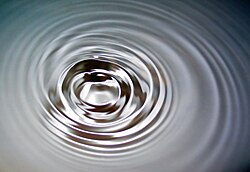Consider two fluid domains, separated by an interface with surface tension. The mean interface position is horizontal. It separates the upper from the lower fluid, both having a different constant mass density,  and and  for the lower and upper domain respectively. The fluid is assumed to be inviscid and incompressible, and the flow is assumed to be irrotational. Then the flows are potential, and the velocity in the lower and upper layer can be obtained from for the lower and upper domain respectively. The fluid is assumed to be inviscid and incompressible, and the flow is assumed to be irrotational. Then the flows are potential, and the velocity in the lower and upper layer can be obtained from  and and  , respectively. Here , respectively. Here  and and  are velocity potentials. are velocity potentials. Three contributions to the energy are involved: the potential energy  due to gravity, the potential energy due to gravity, the potential energy  due to the surface tension and the kinetic energy due to the surface tension and the kinetic energy  of the flow. The part of the flow. The part  due to gravity is the simplest: integrating the potential energy density due to gravity, due to gravity is the simplest: integrating the potential energy density due to gravity,  (or (or  ) from a reference height to the position of the surface, ) from a reference height to the position of the surface,  : [6] : [6] 
assuming the mean interface position is at  . . An increase in area of the surface causes a proportional increase of energy due to surface tension: [7] 
where the first equality is the area in this (Monge's) representation, and the second applies for small values of the derivatives (surfaces not too rough). The last contribution involves the kinetic energy of the fluid: [8] 
Use is made of the fluid being incompressible and its flow is irrotational (often, sensible approximations). As a result, both  and and  must satisfy the Laplace equation: [9] must satisfy the Laplace equation: [9]  and and 
These equations can be solved with the proper boundary conditions:  and and  must vanish well away from the surface (in the "deep water" case, which is the one we consider). must vanish well away from the surface (in the "deep water" case, which is the one we consider). Using Green's identity, and assuming the deviations of the surface elevation to be small (so the z–integrations may be approximated by integrating up to  instead of instead of  ), the kinetic energy can be written as: [8] ), the kinetic energy can be written as: [8] 
To find the dispersion relation, it is sufficient to consider a sinusoidal wave on the interface, propagating in the x–direction: [7] 
with amplitude  and wave phase and wave phase  . The kinematic boundary condition at the interface, relating the potentials to the interface motion, is that the vertical velocity components must match the motion of the surface: [7] . The kinematic boundary condition at the interface, relating the potentials to the interface motion, is that the vertical velocity components must match the motion of the surface: [7]  and and  at at  . .
To tackle the problem of finding the potentials, one may try separation of variables, when both fields can be expressed as: [7] 
Then the contributions to the wave energy, horizontally integrated over one wavelength  in the x–direction, and over a unit width in the y–direction, become: [7] [10] in the x–direction, and over a unit width in the y–direction, become: [7] [10] 
The dispersion relation can now be obtained from the Lagrangian  , with , with  the sum of the potential energies by gravity the sum of the potential energies by gravity  and surface tension and surface tension  : [11] : [11] 
For sinusoidal waves and linear wave theory, the phase–averaged Lagrangian is always of the form  , so that variation with respect to the only free parameter, , so that variation with respect to the only free parameter,  , gives the dispersion relation , gives the dispersion relation  . [11] In our case . [11] In our case  is just the expression in the square brackets, so that the dispersion relation is: is just the expression in the square brackets, so that the dispersion relation is: 
the same as above. As a result, the average wave energy per unit horizontal area,  , is: , is: 
As usual for linear wave motions, the potential and kinetic energy are equal ( equipartition holds):  . [12] . [12] |











![Dispersion of gravity-capillary waves on the surface of deep water (zero mass density of upper layer,
r
'
=
0
{\displaystyle \rho '=0}
). Phase and group velocity divided by
g
s
/
r
4
{\displaystyle \scriptstyle {\sqrt[{4}]{g\sigma /\rho }}}
as a function of inverse relative wavelength
1
l
s
/
(
r
g
)
{\displaystyle \scriptstyle {\frac {1}{\lambda }}{\sqrt {\sigma /(\rho g)}}}
.
* Blue lines (A): phase velocity, Red lines (B): group velocity.
* Drawn lines: dispersion relation for gravity-capillary waves.
* Dashed lines: dispersion relation for deep-water gravity waves.
* Dash-dotted lines: dispersion relation valid for deep-water capillary waves. Dispersion capillary.svg](http://upload.wikimedia.org/wikipedia/commons/thumb/9/9d/Dispersion_capillary.svg/250px-Dispersion_capillary.svg.png)



















































